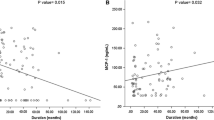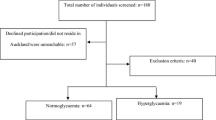Abstract
Background
Differential adipokine expression in obesity influences the inflammatory milieu, and may explain in part obesity’s negative impact on pancreatic disease. Pancreatic juice analysis may provide a good means to evaluate the local pancreatic inflammatory milieu. The presence of adipokines in pancreatic juice is unknown.
Aims
This proof-of-concept study was designed to determine the presence of adipokines and cytokines in human pancreatic juice.
Methods
With institutional review board approval, pancreatic juice was obtained from ten patients with a broad range of diagnoses at the time of endoscopic retrograde cholangiopancreatography. Pancreatic juice was assayed using enzyme-linked immunosorbent assay (ELISA) for insulin, the proinflammatory adipokine leptin, the anti-inflammatory adipokine adiponectin, and the inflammatory mediators interleukin-6 (IL-6), tumor necrosis factor-α (TNF-α), and monocyte chemoattractant protein-1 (MCP-1). Correlation between adipokine and inflammatory mediator expression was determined by linear regression analysis. Data are presented as mean ± standard error of the mean (SEM); P < 0.05 was considered statistically significant.
Results
Leptin (0.16 ± 0.05 ng/ml) and adiponectin (0.63 ± 0.02 μg/ml) were both present, as were the inflammatory mediators IL-6 (112.6 ± 28.1 pg/ml), TNF-α (49.0 ± 18.8 pg/ml), and MCP-1 (32.2 ± 0.9 pg/ml). Paradoxically, the expression of the anti-inflammatory adipokine adiponectin correlated strongly with that of the proinflammatory cytokine IL-6 (R 2 = 0.98, P < 0.001).
Conclusions
This report is the first to describe adipokine expression in human pancreatic juice. Human pancreatic juice inflammatory mediators and adipokines may provide an important measurement of the local pancreatic inflammatory milieu.



Similar content being viewed by others
Explore related subjects
Discover the latest articles and news from researchers in related subjects, suggested using machine learning.References
Shi C, et al. Immune status and inflammatory response differ locally and systemically in severe acute pancreatitis. Scand J Gastroenterol. 2006;41(4):472–480.
Norman J. The role of cytokines in the pathogenesis of acute pancreatitis. Am J Surg. 1998;175(1):76–83.
Denyer ME, Cotton PB. Pure pancreatic juice studies in normal subjects and patients with chronic pancreatitis. Gut. 1979;20(2):89–97.
Kuhlmann KF, et al. Evaluation of matrix metalloproteinase 7 in plasma and pancreatic juice as a biomarker for pancreatic cancer. Cancer Epidemiol Biomarkers Prev. 2007;16(5):886–891.
Matsumoto S, et al. Evaluation of cytology and tumor markers of pure pancreatic juice for the diagnosis of pancreatic cancer at early stages. Pancreas. 1994;9(6):741–747.
Gumbs AA, Gumbs AA. Obesity pancreatitis and pancreatic cancer. Obes Surg. 2008;18(9):1183–1187.
Segersvard R, et al. Obesity alters cytokine gene expression and promotes liver injury in rats with acute pancreatitis. Obesity. 2008;16(1):23–28.
Zyromski NJ, et al. A murine model of obesity implicates the adipokine milieu in the pathogenesis of severe acute pancreatitis. Am J Physiol Gastrointest Liver Physiol. 2008;295(3):G552–G558.
Mathur AZN, Pitt H, Al-Azzawi H, Walker J, Saxena R, Lillemoe K. Pancreatic steatosis promotes dissemination and lethality of pancratic cancer. J Am Coll Surg. 2009 (in press).
Araki H, et al. Adiponectin plays a protective role in caerulein-induced acute pancreatitis in mice fed a high-fat diet. Gut. 2008;57(10):1431–1440.
Chang MC, et al. Adiponectin as a potential differential marker to distinguish pancreatic cancer and chronic pancreatitis. Pancreas. 2007;35(1):16–21.
Kelesidis I, Kelesidis T, Mantzoros CS. Adiponectin and cancer: a systematic review. Br J Cancer. 2006;94(9):1221–1225.
Lawrence AM, et al. Glucagon and insulin in pancreatic exocrine secretions. Lancet. 1979;1(8130):1354–1355.
Antuna-Puente B, et al. Adipokines: the missing link between insulin resistance and obesity. Diabetes Metab. 2008;34(1):2–11.
Conwell DL, et al. The effect of moderate sedation on exocrine pancreas function in normal healthy subjects: a prospective, randomized, cross-over trial using the synthetic porcine secretin stimulated Endoscopic Pancreatic Function Test (ePFT). Am J Gastroenterol. 2005;100(5):1161–1166.
Yoshida K, et al. Screening of genes specifically activated in the pancreatic juice ductal cells from the patients with pancreatic ductal carcinoma. Cancer Sci. 2003;94(3):263–270.
Gronborg M, et al. Comprehensive proteomic analysis of human pancreatic juice. J Proteome Res. 2004;3(5):1042–1055.
Zhou L, et al. Comparative proteomic analysis of human pancreatic juice: methodological study. Proteomics. 2007;7(8):1345–1355.
Chen R, et al. Comparison of pancreas juice proteins from cancer versus pancreatitis using quantitative proteomic analysis. Pancreas. 2007;34(1):70–79.
Bhatia M, et al. Inflammatory mediators in acute pancreatitis. J Pathol. 2000;190(2):117–125.
de Beaux AC, et al. Serum concentrations of inflammatory mediators related to organ failure in patients with acute pancreatitis. Br J Surg. 1996;83(3):349–353.
Jablonowska M, et al. Immunohistochemical localization of interleukin-6 in human pancreatitis. Appl Immunohistochem Mol Morphol. 2008;16(1):40–43.
Yasuda H, et al. Cytokine expression and induction of acinar cell apoptosis after pancreatic duct ligation in mice. J Interferon Cytokine Res. 1999;19(6):637–644.
Kazbay K, et al. Increased transforming growth factor beta in pure pancreatic juice in pancreatitis. Pancreas. 2001;22(2):193–195.
Noh KW, et al. Do cytokine concentrations in pancreatic juice predict the presence of pancreatic diseases? Clin Gastroenterol Hepatol. 2006;4(6):782–789.
Pungpapong S, et al. Endoscopic ultrasound and IL-8 in pancreatic juice to diagnose chronic pancreatitis. Pancreatology. 2007;7(5–6):491–496.
Chen CC, et al. Proinflammatory cytokines in early assessment of the prognosis of acute pancreatitis. Am J Gastroenterol. 1999;94(1):213–218.
Sathyanarayan G, et al. Elevated level of interleukin-6 predicts organ failure and severe disease in patients with acute pancreatitis. J Gastroenterol Hepatol. 2007;22(4):550–554.
Naugler WE, et al. The wolf in sheep’s clothing: the role of interleukin-6 in immunity, inflammation and cancer. Trends Mol Med. 2008;14(3):109–119.
Hoene M, Weigert C. The role of interleukin-6 in insulin resistance, body fat distribution and energy balance. Obes Rev. 2008;9(1):20–29.
Sennello JA, et al. Interleukin-18, together with interleukin-12, induces severe acute pancreatitis in obese but not in nonobese leptin-deficient mice. Proceedings of the National Academy of Sciences of the United States of America, 2008;105(23):8085–8090.
Bastard J-P, et al. Recent advances in the relationship between obesity, inflammation, and insulin resistance. Eur Cytokine Netw. 2006;17(1):4–12.
Kristiansen OP, Mandrup-Poulsen T. Interleukin-6, diabetes: the good, the bad, or the indifferent? Diabetes. 2005;54(Suppl 2):S114–S1124.
Kern PA, et al. Adipose tissue tumor necrosis factor and interleukin-6 expression in human obesity and insulin resistance. Am J Physiol Endocrinol Metab. 2001;280(5):E745–E751.
Carey AL, Febbraio MA. Interleukin-6 and insulin sensitivity: friend or foe? Diabetologia. 2004;47(7):1135–1142.
Acknowledgments
Supported in part by the SSAT Career Development Award (N.J.Z.).
Author information
Authors and Affiliations
Corresponding author
Rights and permissions
About this article
Cite this article
Dalbec, K.M., Max Schmidt, C., Wade, T.E. et al. Adipokines and Cytokines in Human Pancreatic Juice: Unraveling the Local Pancreatic Inflammatory Milieu. Dig Dis Sci 55, 2108–2112 (2010). https://doi.org/10.1007/s10620-009-0977-z
Received:
Accepted:
Published:
Issue Date:
DOI: https://doi.org/10.1007/s10620-009-0977-z




